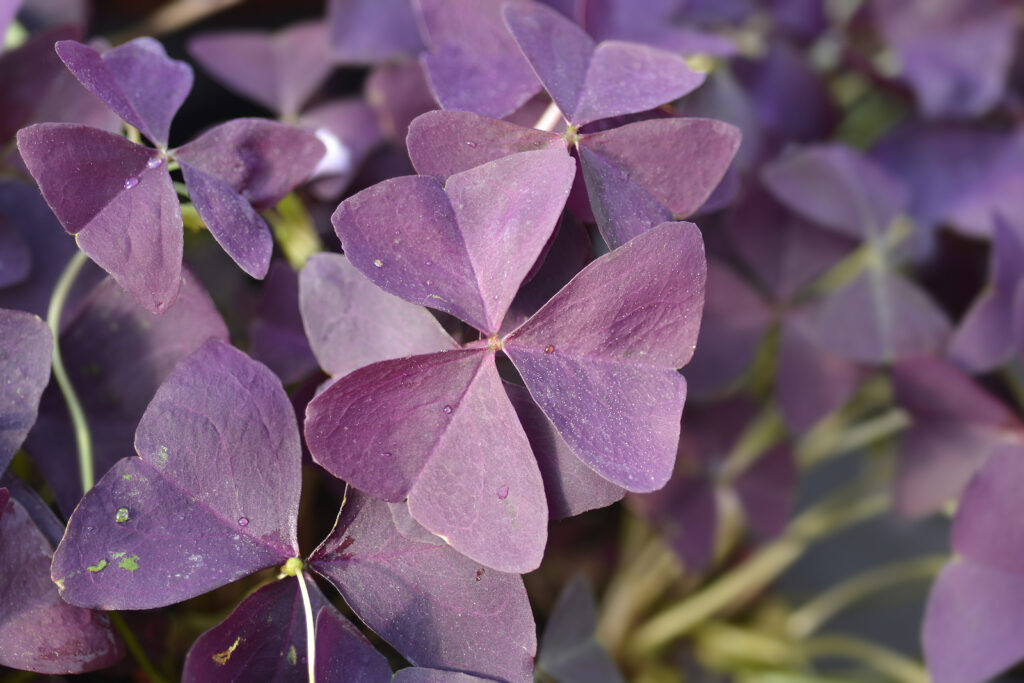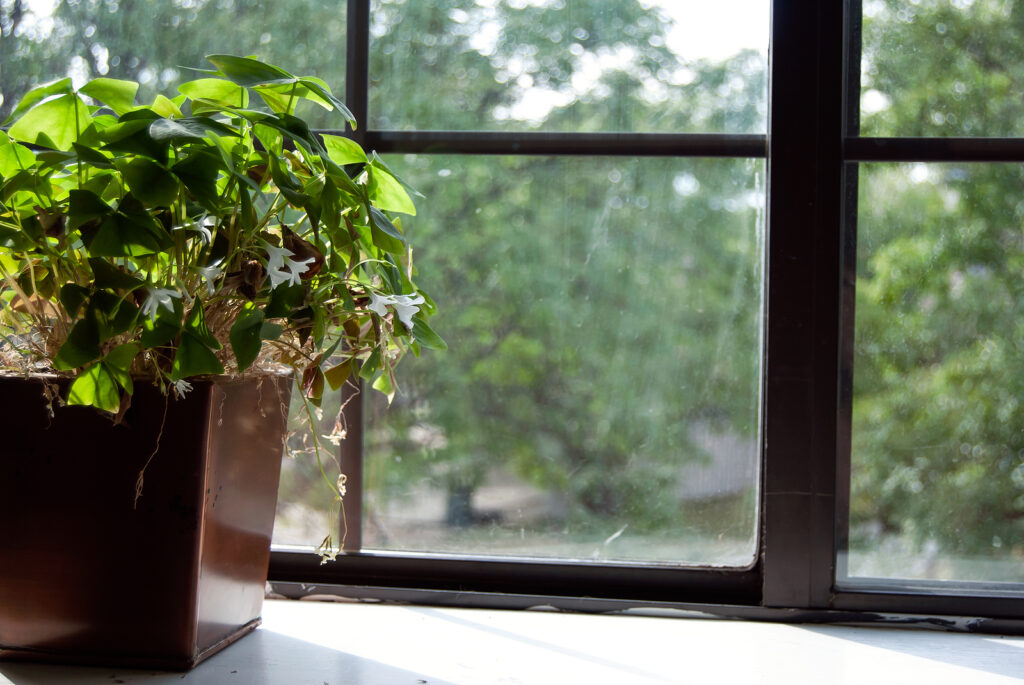Oxalis is a small ornamental plant with shamrock-like, 3-leaflet leaves. Oxalis bears small flowers with five rounded petals; flowers can be pink, white, rose, or yellow. Outdoors Oxalis is suited for a rock garden or garden bed. Some species can become weedy so it is important they are grown so they won’t get in the way or take over.
Oxalis grows best in Mediterranean-like climates where there are cool summers and mild winters. Oxalis tolerates dry soil in summer but grows best with a little moisture.
Grow Oxalis as a houseplant or in containers that can come indoors to a bright spot in winter.
Oxalis is a genus of about 500 species. Some are fibrous-rooted; others are bulbous or rhizomatous. Some Oxalis can become weedy. Even small sections of bulbs left behind at weeding time can produce new plants.

Get to know Oxalis
- Plant type: Perennials; some grow from bulb, tuber, or rhizome.
- Growing zones and range: Zones 5 to 10 depending on the variety.
- Hardiness: Hardy to Zone 5
- Height and width: 2 to 10 inches (5-25cm) tall and nearly as wide depending on the variety.
- Foliage: Attractive cloverlike leaves with three leaflets; sometimes sold as shamrocks; many species have leaves that fold downward at night.
- Flowers: Small, cuplike, pink, red, yellow, or white flowers; flowers have five rounded petals and are solitary or borne in clusters (umbel-like cymes).
- Bloom time: Indoors in pots: late winter, early spring. Outdoors: in late spring and summer.
- Uses: Groundcover (can be invasive) or houseplant
- Garden companions: Wild columbine (Aquilegia canadensis).
- Common name: Shamrocks, sorrels.
- Botanical name: Oxalis
- Family name: Oxalidaceae
- Origin: Southern Africa and South America
Where to plant Oxalis
- Plant Oxalis in full sun or light shade.
- Where summers are hot, look for a cool, north-facing site or one that receives shade during the hottest part of the day.
- Where winters are wet, grow them in raised beds or rock gardens with very well-drained soil: wet feet in winter spell disaster.
- Plant Oxalis in well-drained, fertile soil outdoors; somewhat sandy or gritty soil is best.
When to plant Oxalis
- Plant Oxalis seed outdoors in late winter or early spring.
- To grow Oxalis in containers, plant the tubers or bulbs in pots or bulb pans (shallow pots) at the beginning of their growing season—spring for most, except O.adenophylla, which should be started in a cool greenhouse in fall.
Planting and spacing Oxalis
- Plant Oxalis bulbs, tubers, or rhizomes 2 inches (5cm) deep.
- Space Oxalis 4 to 10 inches (10-25cm) apart; oxalis reproduces quickly.

How to water and feed Oxalis
- Give Oxalis regular water.
- Oxalis plants tolerate dry soil in summer, but they are best with a little moisture.
- Soak the soil at potting time, then water very sparingly until leaves emerge and the plants begin growing actively.
- Keep the soil evenly moist and feed regularly throughout the growing season.
- In late summer or fall, gradually withhold water as the leaves begin to die back.
- Oxalis does not require feeding; to encourage quick growth, feed with granular bulb food.
How to care for Oxalis
- At the northern limits of Oxalis hardiness, protect plants over winter with coarse mulch such as evergreen boughs, pine needles, or salt hay.
- For best growth, protect Oxalis from the hottest sun of the day.
Growing Oxalis as a houseplant
- Grow Oxalis in a cool to average toom where light is direct and humidity is average.
- Plant in a well-drained, soilless medium that is allowed to dry out slightly between waterings.
- Fertilize monthly during the growing and flowering period.
- After the plant has flowered, the foliage turns brown and dies back.
- Store plants in their pot until fall, when they should be returned to the house and the process repeated.
Oxalis pests and diseases
- Oxalis can develop mildew, leaf spot, or rust.
- Oxalis is susceptible to leaf miners and spider mites.
Oxalis propagation
- Separate Oxalis offset or divide the tubers in early spring.
- Sow seed in warm soil in late winter or early spring.
Oxalis varieties to grow
- Oxalis acetosella, wood sorrel, shamrock: one of several plants known as shamrock.
- O. adenophylla has pink blooms and silvery-green leaves; dense, low—4-6 inches (10.2-15.2cm) tall—compact, tuft leaves, each leaf with 12-22 crinkly, gray-green leaflets; flowers are 1 inch (2.5cm) wide, on 4-6 inch (10.2-15.2cm) stalks, bell-shaped, lilac pink with deeper veins in late spring; good for rock gardens or as a container plant in colder-winter zones; good companion to bulbs such as species tulips or the smaller kinds of narcissus, in pots, or in the ground; plant roots in fall; needs good drainage. Zones 5 to 8.
- O. bowiei (formerly O. purpurata), wood sorrel, Oxalis: grows 8-10 inch (20.3-25.4cm) tall South African species that grows from tunicate bulbs and has leathery, clover-like, three-leaflet leaves that are green above and sometimes purple below; bears clusters (umbel-like cymes) of 3-12 funnel-shaped 1.5 inches (3.8cm) wide flowers from summer to fall that are purple-pink to rose-red with green throats. Zones 8 to 10.
- O. deppei is the four-leaf clover; it grows to 15 inches (38cm) tall.
- O. enneaphylla has fragrant, white to red, 1-inch (2.5cm) wide flowers over attractive clumps of foliage. 3 inches (7.6cm) tall; cultivar ‘Rosea’ is light pink. Zones 6 to 9.
- O. oregana, redwood sorrel, Oregon oxalis: native to coastal forests of Washington to California; creeping white roots send up velvety, medium green leaves 1.5-4 inches (3.8-10.2cm) wide on stems 2-10 inches (5.1-25.4cm) high; blooms in spring, sometimes again in fall; flowers to 1 inch (2.5cm) across, pink or white veined with lavender; interesting ground cover for part shade to deep shade in mild-winter/cool summer areas.
- O. montana, Common woodsorrel, has white flowers with pink veins; a good choice for woodland gardens. 6 inches (15.2cm) tall. Zones 3 to 8.
- O. purpurea (O. variabilis) low-growing—4-5 inches (10.2-12.7cm)—with large leaves and rosy red flowers an inch (2.5cm) across; spreads by bulbs and rhizome-like roots, but is not aggressive or weedy; plant bulbs in early fall for late fall and winter bloom; improved kinds sold under the name Grand Duchess; have large flowers of rose pink, white, or lavender.
- O. regnellii var. atropurpurea has pink leaves and lavender flowers.
- O. rubra has pink flowers, and its leaflets are coppery green.
- O. roseas grows to 18 inches (45cm) tall; the flowers are rose and have darker veins and white throats.
- O. tetraphylla, Good luck plant, also known as four-leaved pink sorrel: forms mounds to 12 inches (30.1c) tall; bears cloverlike 3-inch (7.6cm) long green leaves tinged with purple at the base and funnel-shaped, pink flowers; use as bedding or border plant, as well as in containers; it grows well in sun or shade. . Zones 7 to 10.
- O. versicolor, container plant in colder-winter zones; bulbs give rise to erect or spreading stems up to 6 inches (15.2cm) tall; leaves bear three deeply notched leaflets less than .5 inch (1.3cm) wide; flowers are white, over 1 inch (2.5cm) wide, with a yellow throat and purplish margins. The variety commonly seen is ‘Candy Cane’, with white flowers striped red; striped buds especially colorful; plant oxalis in fall for spring bloom.
Oxalis frequently asked questions
Q: How do I grow oxalis indoors?
A: Grow 3 or 4 oxalis bulbs in a 4-inch pot or bulb pan in porous, fertile soil. Water carefully at first and then more freely as growth develops. When the plant’s roots fill the pot, repot in a 5-inch pot. When the plant stops blooming, gradually reduce water and keep the soil dry through summer. Grow oxalis in temperatures near 60℉.
Q: Why can’t I grow oxalis successfully in the house?
A: Probably because the environment is not suitable. Oxalis needs plenty of sunlight, ample water during the growing season, and none during the dormant period. Oxalis wants loose, porous soil, and a temperature of 55° to 65℉.
Q: Where is the best place to grow oxalis?
A: Grow oxalis in a pot or in hanging baskets in a greenhouse, sunroom, or sunny window.
Q: How do I store oxalis when it is not blooming?
A: During the dormant season, leave oxalis bulbs in the soil in pots, keep them dry, and store them in a cool cellar or shed.
Q: Why do oxalis bloom for only a short time?
A: Oxalis has a definite season of bloom. Unlike some geraniums, begonias, and fuchsias, they do not produce flowers over a period of months.
Q: Why does oxalis fail to bloom?
A: Probably lack of sufficient sunlight. Oxalis must be exposed to sunlight to bloom. Overcrowding or poor soil, and low humidity can also result in failure to bloom.















